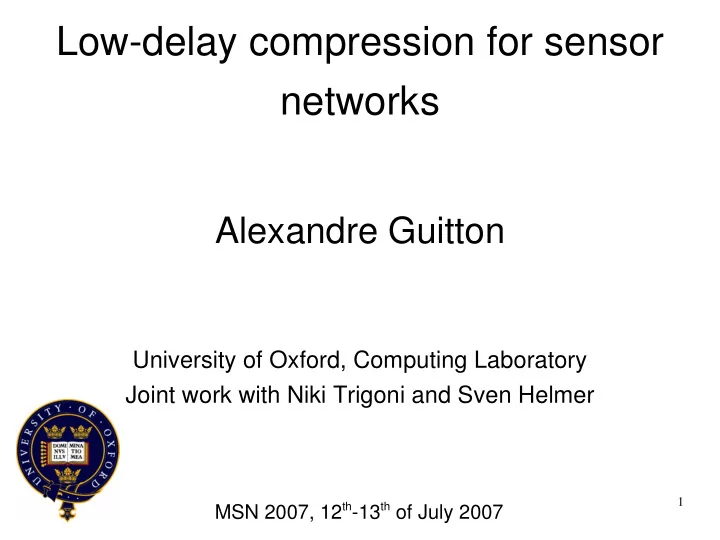

Low-delay compression for sensor networks Alexandre Guitton University of Oxford, Computing Laboratory Joint work with Niki Trigoni and Sven Helmer 1 MSN 2007, 12 th -13 th of July 2007
Outline ● Motivation ● Existing compression techniques – Standard compression (LZW, Adaptive Huffman) – Compression with packet retransmissions (RT) ● Proposed fault-tolerant compression (FT) ● Evaluation and conclusions 2
Motivation ● Sensor nodes are battery powered – To save energy: compressing data before transmitting it ● Challenge: lossy communication channels ● Performance metrics Bytes of uncompressed data at the receiver – Energy-efficiency: Bytes transmitted by the sender – Delay between first transmission and decoding 3
Our focus Receiver Sender Application Application raw data uncompressed data Compression Decompression compressed packets compressed packets Error correction encoding Error correction decoding sent packets 4 Link
Existing approaches Standard compression Zebra sensing Zebra sensing “Zebra seen at 8:00 in (20,30)” “Zebra ” LZW LZW 0010 0010 1011 X 1100 1100 1010 1010 Hamming encoding Hamming decoding 0010(01) 1011(10) 0010(01) 0 01 0 ( 01 ) 1100(00) 1010(11) 1100(0 1 ) 101 1 (11) 5
Existing approaches Standard compression Compressing data with dynamic dictionaries is less energy-efficient than not compressing it when the packet drop rate exceeds 10% 6
Existing approaches Compression with retransmissions ● Retransmission (RT) mechanism [Sadler and Martonosi, 2006] to cope with packet losses – Packets are grouped in blocks – Receiver sends block ACKs – Sender retransmits dropped packets – Compression is restarted at each block ● RT is applied to LZW (RT-LZW) 7
Existing approaches Compression with retransmissions Sender Receiver abc def ghi jkl mno 10111 def 11111 11111 8
Existing approaches Compression with retransmissions Sender Receiver Problem 1 abc def ghi jkl mno Packets cannot be decoded as they 10111 arrive, they have to def be decoded in order 11111 11111 9
Existing approaches Compression with retransmissions Sender Receiver Problem 1 abc def ghi jkl mno Packets cannot be decoded as they 10111 arrive, they have to 10111 be decoded in order Problem 2 10111 In the event of a disconnection, the 10111 effort of the sender 10111 is wasted 10
Existing approaches Compression with retransmissions ● To address these two problems – Small blocks are used (the delay is not too large, and energy is not wasted in case of a disconnection) – The dictionary is restarted at the beginning of each block (blocks are independent of each other) ● But – Small blocks reduce the potential for compression 11
Proposed fault-tolerant mechanism ● Fault-Tolerant (FT) mechanism – Packets are grouped in blocks (as in RT) – Block ACKs (as in RT) – Dictionary is updated after each block (NOT after each symbol) – Each packet of a block can be decoded independently of the other packets of the block 12
Proposed fault-tolerant mechanism Sender Receiver 0 abc 0 def 0 ghi 0 jkl 0 mno 10111 Dictionary updated with abcghijklmno 13
Proposed fault-tolerant mechanism Sender Receiver 0 abc 0 def 0 ghi 0 jkl 0 mno 10111 1 def 1 pqr Dictionary updated with abcghijklmno 14
Proposed fault-tolerant mechanism Sender Receiver 0 abc 0 def 0 ghi 0 jkl 0 mno 10111 1 def 1 pqr 1 stu 1 vwx 1 yza 15
Proposed fault-tolerant mechanism Sender Receiver 0 abc 0 def 0 ghi 0 jkl 0 mno 10111 1 def 1 pqr 1 stu 1 vwx 1 yza 01111 16
Proposed fault-tolerant mechanism Sender Receiver 0 abc 0 def 0 ghi 0 jkl 0 mno 10111 1 def 1 pqr 1 stu 1 vwx 1 yza 01111 0 def 0 bcd 0 efg 0 hij 0 klm 17
Proposed fault-tolerant mechanism Sender Receiver Problem 1? 0 abc 0 def 0 ghi 0 jkl 0 mno Packets can be decoded as soon 10111 as they arrive 1 def 1 pqr 1 stu 1 vwx 1 yza 01111 0 def 0 bcd 0 efg 0 hij 0 klm 18
Proposed fault-tolerant mechanism Sender Receiver Problem 1? 0 abc 0 def 0 ghi 0 jkl 0 mno Packets can be decoded as soon 10111 as they arrive 1 def 1 pqr 1 stu 1 vwx 1 yza Problem 2? In the event of a 01111 disconnection, all the packets that 01111 have been received 01111 are useful 19
Proposed fault-tolerant mechanism ● Advantages of FT over the RT mechanism – Packet can be decoded when they arrive – Dictionaries are not reinitialized at each block – Availability of the backward link is not mandatory ● Disadvantage – Compression is conservative because the dictionary is only updated at the end of each block 20
Experimental setup ● We applied the RT and FT mechanism to LZW (RT-LZW and FT-LZW) – Real road traffic dataset (Scoot) – Block sizes of 20 and 66 packets – Varied packet loss rate on a link from 0% to 90% ● We measure – Energy-efficiency – Delay 21
Evaluation - Energy-efficiency The energy-efficiency of RT-LZW increases with the block size 22
Evaluation - Energy-efficiency (1) The energy-efficiency of FT-LZW decreases as the block size increases and (2) small block sizes cannot be used in highly lossy environments 23
Evaluation - Energy-efficiency RT and FT mechanisms (1) degrade linearly as the packet drop rate increases, and (2) are comparable 24
Evaluation - Delay FT is 2-3 times faster than RT for all block sizes 25
Conclusions ● Standard compression algorithms fail in lossy environments ● FT is comparable to RT in terms of energy- efficiency in static networks, and better in dynamic networks ● FT is 2 to 3 times faster than RT 26
FT RT Thank you 27
Evaluation - Energy-efficiency 28
Evaluation - Energy-efficiency 29
Evaluation - Energy-efficiency 30
Evaluation - Delay 31
Recommend
More recommend